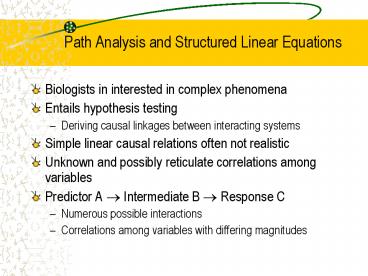Path Analysis and Structured Linear Equations PowerPoint PPT Presentation
1 / 14
Title: Path Analysis and Structured Linear Equations
1
Path Analysis and Structured Linear Equations
- Biologists in interested in complex phenomena
- Entails hypothesis testing
- Deriving causal linkages between interacting
systems - Simple linear causal relations often not
realistic - Unknown and possibly reticulate correlations
among variables - Predictor A ? Intermediate B ? Response C
- Numerous possible interactions
- Correlations among variables with differing
magnitudes
2
Path Analysis
- What tools are available to Ecologists and
Evolutionary Biologists for analyzing systems
with multiple causality? - Multiple Regression?
- Path Analysis
- Increasingly common
- Two methods are related
- Use former to estimate the latter
3
Goals of Path Analysis
- Hypothesis Testing
- Exploratory Data Analysis
4
Origins of Path Analysis
- Developed by Sewell Wright
- Formulated in series of papers published in 1918,
1921, 1934, 1960 - Derived to partition direct and indirect
relationships among variables - Path Analysis deals with dependency relationships
among variables - Key is that investigator specified the order of
dependency
5
Mechanics of Path Analysis
- Derive a model of dependency
- Partition relationships among the different
pathways - Not necessarily a simultaneous method
- Originally did not include overall tests of model
fit to the data - Recently Path Analysis superceded by SEM
- Structured Equation Modelling
6
Meaning of Path Models
- Path Models are presumed to represent causal
hypotheses - A significant path model does not imply causality
- Rather one can use the model to test for
causality using experimental data or in a
confirmatory model with additional data
7
Indirect and Direct Effects
- Two ways that a predictor variable may affect a
response variable - First, there is a direct effect of variable x1 on
y - I.e., x1 ? y
- Second, there is an indirect effect of variable
x1 on y through another correlated predictor
variable.
8
General Path Model
Yj
Z
Xi
p1
p6
p2
p3
p4
p7
p5
U2
U1
9
Elaboration of the Path Model
- Path coefficients designated by pi
- Unexplained variation is given by U
- Correlations are designated by ri
- Correlations shown by double arrows
- Paths by single arrows
- Negative Paths traditionally are designated with
dashed lines
10
Estimation of Path Coefficients
- Typically use Multiple Regression to estimate
path coefficients - Either standardize the x and y variables and then
run the regression or - Request the output of standardized partial
regression coefficients - Decomposition of Correlations
- Factor Analysis
11
Assumptions of Path Model
- Assume linear and additive relationships
- Excludes curvilinear and multiplicative models
- Error terms are uncorrelated with one another
- Recursive models only one way causal flows
- Observed variables measured without error
- Model is correctly specified
- All causal determinants properly included in
model - If causal variables excluded it is because they
are independent of those that were included
12
Path Coefficients
- Can compute from simple correlations
- For one x and one y
- Path is
- pXY rXY
- For two x variables and a single y
- Y1 pY1X1x1 pY1X2x2 eY1
- rX1Y1 pX1Y1 PY1X2rX1X2
- This shows that the correlation between x and y
has a direct and indirect component - Residual is given by ?1-R2yi.jklp
13
Dark Side of Path Analysis
- Collinearity
- Unstable beta weights (paths)
- Incompletely specified path models
- Use of categorical variables in paths
- Low sample size
14
Path Analysis of Morphology?Performance
- Morphological variables from juvenile Urosaurus
ornatus - Performance variables
- Initial Velocity
- Maximum Velocity
- Stride Length
- Stride Frequency

